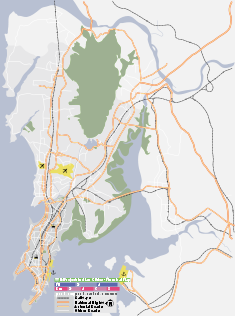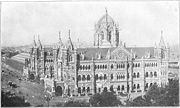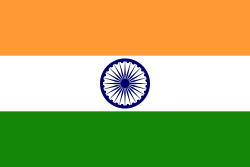Chhatrapati Shivaji Terminus
 Chhatrapati Shivaji Terminus, formerly Victoria Terminus |
|
 Shown within Mumbai
|
|
|---|---|
| Building | |
| Architectural style | Indo-Saracenic |
| Town | Mumbai |
| Country | India |
| Client | Government of Bombay |
| Construction | |
| Started | 1889 |
| Completed | 1897 |
| Cost | 1,614,000 Rupees |
| Design team | |
| Architect | Axel Herman, Frederick William Stevens |
| Engineer | Frederick William Stevens |
Chhatrapati Shivaji Terminus (Marathi: छत्रपती शिवाजी टर्मिनस), formerly Victoria Terminus, and better known by its abbreviation CST or Bombay VT) is a historic railway station in Mumbai which serves as the headquarters of the Central Railways. It is one of the busiest railway stations in India, and serves Central Railway trains terminating in Mumbai as well as the Mumbai suburban railway.
Contents |
History
The station was designed by Frederick William Stevens, a consulting architect in 1887-1888. He received as payment 16.14 lakh rupees.[1] Stevens earned the commission to construct the station after a masterpiece watercolour sketch by draughtsman Axel Haig.[1] The final design bears some resemblance to St Pancras station in London.[1][2]
It took ten years to complete[2] and was named "Victoria Terminus" in honour of the Queen and Empress Victoria; it was opened on the date of her Golden Jubilee in 1887.[2][3] This famous architectural landmark in Gothic style was built as the headquarters of the great Indian Peninsular Railway. Since then the station came to be known as Bombay VT.
In 1996, in response to demands by the Shiv Sena and in keeping with the policy of renaming locations with Indian names, the station was renamed by the state government after Chhatrapati Shivaji, a famed 17th century Maratha king. On 2 July 2004 the station was nominated a World Heritage Site by the World Heritage Committee of UNESCO.
On 26 November 2008, armed with AK-47 rifles, two terrorists entered the passenger hall of the CST, opened fire and threw grenades, killing at least 40 people.[4]
The structure

| Chhatrapati Shivaji Terminus (formerly Victoria Terminus)* | |
|---|---|
| UNESCO World Heritage Site | |
| State Party | |
| Type | Cultural |
| Criteria | ii, iv |
| Reference | 945 |
| Region** | Asia-Pacific |
| Inscription history | |
| Inscription | 2004 (28th Session) |
| * Name as inscribed on World Heritage List. ** Region as classified by UNESCO. |
|
The station building was designed in the Victorian Gothic style of architecture. The building exhibits a fusion of influences from Victorian Italianate Gothic Revival architecture and traditional Indian architecture. Internally, the wood carving, tiles, ornamental iron and brass railings, grills for the ticket offices, the balustrades for the grand staircases and other ornaments were the work of students at the Bombay School of Art. The station stands as an example of 19th century railway architectural marvels for its advanced structural and technical solutions.
Suburban Network
The network of suburban trains (locally known as locals, short for local trains) radiating out from this station is instrumental in keeping Mumbai running. The station serves long-distance trains as well as two of the suburban lines-the Central Line and the Harbour line. It is the westernmost terminus of Central Railway. Local trains terminate at Karjat, Kasara, Panvel, Khopoli,Dombivli , Kalyan, Asangaon, Titwala, Ambernath, Badlapur, Thane and Dahanu.
Gallery
See also
- Bori Bunder
- Timeline of Mumbai events
References
- ↑ 1.0 1.1 1.2 "Chhatrapati Shivaji Station". World Heritage Site. www.worldheritagesite.org. Retrieved on 2008-12-03.
- ↑ 2.0 2.1 2.2 "Advisory Body Evaluation: Chhatrapati Shivaji Terminus (India)" (pdf). UNESCO - World heritage - documents associated with listing. UNESCO (2004). Retrieved on 2008-12-03.
- ↑ Image
- ↑ Associated Press, The. "At Least 40 Dead in India in Coordinated Attacks - NYTimes.com". Nytimes.com. Retrieved on 2008-11-26.
External links
- Chhatrapati Shivaji Terminus on the UNESCO website
- Chhatrapati Shivaji Terminus Mumbai
- Google Satellite Map of Mumbai CST
|
|||||||
|
||||||||||||||||||||||||||||||||
| Chatrapati Shivaji Terminus | ||||
| Next station south: None |
Mumbai suburban railway : Central Railway | Next station north: Masjid Bunder |
||
| Stop No: 1 | KM from starting: 0 | Platforms: 17 | ||
|
|||||
| Chatrapati Shivaji Terminus | ||||
| Next station south: None |
Mumbai suburban railway : Central Railway (Harbour Line) | Next station north: Masjid Bunder |
||
| Stop No: 1 | KM from starting: 0 | Platforms: 17 | ||
|
|||||
